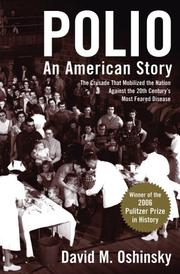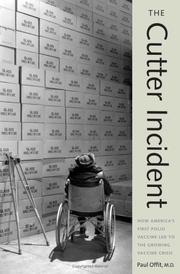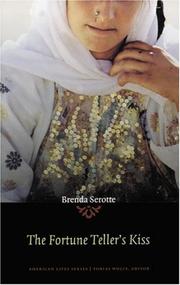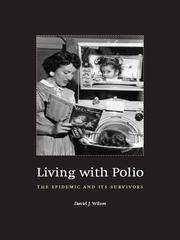| Listing 1 - 10 of 12 | << page >> |
Sort by
|

ISBN: 1280501987 1423746538 0199726590 1602568251 9780199726592 9781423746539 9780195152944 0195152948 9781602568259 9781280501982 9786610501984 661050198X 9780199840083 0199840083 0195307143 9780195307146 Year: 2005 Publisher: Oxford, [England] ; New York, New York : Oxford University Press,
Abstract | Keywords | Export | Availability | Bookmark
 Loading...
Loading...Choose an application
- Reference Manager
- EndNote
- RefWorks (Direct export to RefWorks)
This is the gripping story of the 1950s polio epidemic that terrified America and how it was conquered in a bitter competition between two brilliant scientists.
Poliomyelitis --- Anterior spinal paralysis --- Infantile paralysis --- Paralysis, Anterior spinal --- Paralysis, Infantile --- Polio --- Central nervous system --- Enterovirus diseases --- Myelitis --- History --- Infections
Book
ISBN: 0870205870 9780870205873 9780870205804 0870205803 Year: 2013 Publisher: Madison, WI : Wisconsin Historical Society Press,
Abstract | Keywords | Export | Availability | Bookmark
 Loading...
Loading...Choose an application
- Reference Manager
- EndNote
- RefWorks (Direct export to RefWorks)
Poliomyelitis --- Anterior spinal paralysis --- Infantile paralysis --- Paralysis, Anterior spinal --- Paralysis, Infantile --- Polio --- Central nervous system --- Enterovirus diseases --- Myelitis --- Patients --- Infections --- Apps, Jerold W., --- Apps, Jerry, --- Health.

ISBN: 1281722103 9786611722104 0300130376 9780300130379 9780300108644 0300108648 9781281722102 9780300126051 Year: 2005 Publisher: New Haven, Connecticut : Yale University Press,
Abstract | Keywords | Export | Availability | Bookmark
 Loading...
Loading...Choose an application
- Reference Manager
- EndNote
- RefWorks (Direct export to RefWorks)
Vaccines have saved more lives than any other single medical advance. Yet today only four companies make vaccines, and there is a growing crisis in vaccine availability. Why has this happened? This remarkable book recounts for the first time a devastating episode in 1955 at Cutter Laboratories in Berkeley, California, that has led many pharmaceutical companies to abandon vaccine manufacture. Drawing on interviews with public health officials, pharmaceutical company executives, attorneys, Cutter employees, and victims of the vaccine, as well as on previously unavailable archives, Dr. Paul Offit offers a full account of the Cutter disaster. He describes the nation's relief when the polio vaccine was developed by Jonas Salk in 1955, the production of the vaccine at industrial facilities such as the one operated by Cutter, and the tragedy that occurred when 200,000 people were inadvertently injected with live virulent polio virus: 70,000 became ill, 200 were permanently paralyzed, and 10 died. Dr. Offit also explores how, as a consequence of the tragedy, one jury's verdict set in motion events that eventually suppressed the production of vaccines already licensed and deterred the development of new vaccines that hold the promise of preventing other fatal diseases.
Poliomyelitis vaccine --- Poliomyelitis --- Vaccines --- Biologicals --- Anterior spinal paralysis --- Infantile paralysis --- Paralysis, Anterior spinal --- Paralysis, Infantile --- Polio --- Central nervous system --- Enterovirus diseases --- Myelitis --- Live poliovirus vaccine --- Salk vaccine --- History. --- Vaccination --- Infections --- Prevention --- Cutter Laboratories. --- Cutter Group --- Cutter Analytic Laboratory

ISBN: 0674043545 9780674043541 9780674013155 0674013158 Year: 2009 Publisher: Cambridge, MA
Abstract | Keywords | Export | Availability | Bookmark
 Loading...
Loading...Choose an application
- Reference Manager
- EndNote
- RefWorks (Direct export to RefWorks)
In this book, Shell, himself a victim of polio, offers an inspired analysis of the disease. Part memoir, part cultural criticism and history, part meditation on the meaning of disease, Shell's work combines the understanding of a medical researcher with the sensitivity of a literary critic. He deftly draws a detailed yet broad picture of the lived experience of a crippling disease as it makes it way into every facet of human existence.
Poliomyelitis --- People with disabilities in motion pictures. --- Culture in motion pictures. --- Motion pictures --- Handicapped in motion pictures --- Anterior spinal paralysis --- Infantile paralysis --- Paralysis, Anterior spinal --- Paralysis, Infantile --- Polio --- Central nervous system --- Enterovirus diseases --- Myelitis --- Social aspects --- Patients --- Infections
Book
ISBN: 1108355420 1108420842 1108368964 1108372740 Year: 2018 Publisher: Cambridge : Cambridge University Press,
Abstract | Keywords | Export | Availability | Bookmark
 Loading...
Loading...Choose an application
- Reference Manager
- EndNote
- RefWorks (Direct export to RefWorks)
By the end of the 1950s, Hungary became an unlikely leader in what we now call global health. Only three years after Soviet tanks crushed the revolution of 1956, Hungary became one of the first countries to introduce the Sabin vaccine into its national vaccination programme. This immunization campaign was built on years of scientific collaboration between East and West, in which scientists, specimens, vaccines and iron lungs crossed over the Iron Curtain. Dóra Vargha uses a series of polio epidemics in communist Hungary to understand the response to a global public health emergency in the midst of the Cold War. She argues that despite the antagonistic international atmosphere of the 1950s, spaces of transnational corporation between blocs emerged to tackle a common health crisis. At the same time, she shows that epidemic concepts and policies were influenced by the very Cold War rhetoric that medical and political cooperation transcended. This title is also available as Open Access.
Poliomyelitis --- Poliomyelitis vaccine, Oral --- World health --- History. --- History --- Global health --- International health --- Public health --- Medical geography --- Oral poliomyelitis vaccine --- Anterior spinal paralysis --- Infantile paralysis --- Paralysis, Anterior spinal --- Paralysis, Infantile --- Polio --- Central nervous system --- Enterovirus diseases --- Myelitis --- International cooperation --- Infections --- iron curtain --- polio; Hungary
Book
ISBN: 9352801091 1281963860 9786611963866 8132100506 9788132100508 9788178298665 Year: 2008 Publisher: Thousand Oaks, Calif. SAGE Publications
Abstract | Keywords | Export | Availability | Bookmark
 Loading...
Loading...Choose an application
- Reference Manager
- EndNote
- RefWorks (Direct export to RefWorks)
The Vital Drop: Communication for Polio Eradication in India explains why. communication is critical in ensuring the success of public health initiatives. Since a significant outbreak of polio in the country in 2002, several innovative. strategies were introduced to ensure better outreach and efficacy of the intensified. pulse polio initiative. This book records the communication journey that began. in 2002 through important innovations aimed at including segregated and marginalised. populations, as well as a very successful mass media campaign featuring cine star. Amitabh Bachchan. An importa
Poliomyelitis --- Mass media in health education --- Communication in medicine --- Health education --- Health --- Hygiene --- Education --- Health promotion --- Preventive health services --- Health communication --- Medical communication --- Medicine --- Anterior spinal paralysis --- Infantile paralysis --- Paralysis, Anterior spinal --- Paralysis, Infantile --- Polio --- Central nervous system --- Enterovirus diseases --- Myelitis --- Prevention. --- Study and teaching --- Infections

ISBN: 1280466251 9786610466252 0803253877 9780803253872 9780803243262 080324326X Year: 2006 Publisher: Lincoln University of Nebraska Press
Abstract | Keywords | Export | Availability | Bookmark
 Loading...
Loading...Choose an application
- Reference Manager
- EndNote
- RefWorks (Direct export to RefWorks)
This is the memoir of a Sephardic Jewish girl living among Ashkenazi neighbors in the Bronx. She comes down with polio just before her eighth birthday. She begins a fight against immobility set within a cultural realm where Catholic and Jew and Turkish Moslem once met. Where a beautiful aunt could be abducted into a Turkish harem and another aunt could still keep the 400-year-old iron key to the family house in the Cordoba of the Spanish Inquisition.
Jews --- Sephardim --- Poliomyelitis --- Jews, Turkish --- Turkish Jews --- Anterior spinal paralysis --- Infantile paralysis --- Paralysis, Anterior spinal --- Paralysis, Infantile --- Polio --- Central nervous system --- Enterovirus diseases --- Myelitis --- Jews, Sephardic --- Ladinos (Spanish Jews) --- Sefardic Jews --- Sephardi Jews --- Sephardic Jews --- Jews, Portuguese --- Jews, Spanish --- Patients --- Infections --- Serotte, Brenda --- Childhood and youth. --- Bronx (New York, N.Y.) --- New York (N.Y.) --- Borough of Bronx (New York, N.Y.) --- Bronx (Borough) --- The Bronx (New York, N.Y.) --- Bronx County (N.Y.)

ISBN: 1281966835 9786611966836 0226901068 9780226901060 9780226901046 9780226901039 0226901033 Year: 2005 Publisher: Chicago University of Chicago Press
Abstract | Keywords | Export | Availability | Bookmark
 Loading...
Loading...Choose an application
- Reference Manager
- EndNote
- RefWorks (Direct export to RefWorks)
Polio was the most dreaded childhood disease of twentieth-century America. Every summer during the 1940's and 1950's, parents were terrorized by the thought that polio might cripple their children. They warned their children not to drink from public fountains, to avoid swimming pools, and to stay away from movie theaters and other crowded places. Whenever and wherever polio struck, hospitals filled with victims of the virus. Many experienced only temporary paralysis, but others faced a lifetime of disability. Living with Polio is the first book to focus primarily on the personal stories of the men and women who had acute polio and lived with its crippling consequences. Writing from personal experience, polio survivor Daniel J. Wilson shapes this impassioned book with the testimonials of more than one hundred polio victims, focusing on the years between 1930 and 1960. He traces the entire life experience of the survivors-from the alarming diagnosis all the way to the recent development of post-polio syndrome, a condition in which the symptoms of the disease may return two or three decades after they originally surfaced. Living with Polio follows every physical and emotional stage of the disease: the loneliness of long separations from family and friends suffered by hospitalized victims; the rehabilitation facilities where survivors spent a full year or more painfully trying to regain the use of their paralyzed muscles; and then the return home, where they were faced with readjusting to school or work with the aid of braces, crutches, or wheelchairs while their families faced the difficult responsibilities of caring for and supporting a child or spouse with a disability. Poignant and gripping, Living with Polio is a compelling history of the enduring physical and psychological experience of polio straight from the rarely heard voices of its survivors.
Poliomyelitis --- Postpoliomyelitis syndrome --- Post-polio syndrome --- Postpolio syndrome --- Postpoliomyelitis muscular atrophy --- Muscular atrophy --- Syndromes --- Anterior spinal paralysis --- Infantile paralysis --- Paralysis, Anterior spinal --- Paralysis, Infantile --- Polio --- Central nervous system --- Enterovirus diseases --- Myelitis --- Complications --- Infections --- polio, epidemic, sickness, disease, illness, medical, medicine, poliomyelitis, infectious, poliovirus, central nervous system, muscle weakness, paralysis, history, historical, 20th century, united states of america, american society, children, childhood, crippling, disability, personal stories, testimonials, diagnosis, post-polio syndrome, hospitalization, hospitals, treatment, braces, crutches, postpoliomyelitis, recovery, rehabilitation.
Book
ISBN: 1922235857 9781922235855 9781922235848 1922235849 Year: 2015 Publisher: Clayton $b Monash University Publishing
Abstract | Keywords | Export | Availability | Bookmark
 Loading...
Loading...Choose an application
- Reference Manager
- EndNote
- RefWorks (Direct export to RefWorks)
Across most of the world, an entire generation has lived free from the spectre of polio, but for fifty years during the twentieth century that fear was overwhelming. Dancing in My Dreams investigates the disease of polio and its treatment over a long period, the scientific endeavour that led to the discovery of the poliovirus, and the early studies in virology and immunology that culminated in the production of a polio vaccine. For the first time, in a history of this disease, the voice of the polio survivor can also be clearly heard.
Poliomyelitis --- Anterior spinal paralysis --- Infantile paralysis --- Paralysis, Anterior spinal --- Paralysis, Infantile --- Polio --- Central nervous system --- Enterovirus diseases --- Myelitis --- History. --- Treatment. --- Prevention. --- Vaccination. --- Infections --- Poliomyelitis vaccine --- Poliovirus --- Encephalitis, Polio --- Epidemic Acute Poliomyelitis --- Polio Encephalitis --- Poliomyelitis Infection --- Poliomyelitis, Acute --- Infantile Paralysis --- Poliomyelitis, Nonpoliovirus --- Poliomyelitis, Preparalytic --- Acute Poliomyelitis --- Acute Poliomyelitis, Epidemic --- Infection, Poliomyelitis --- Infections, Poliomyelitis --- Nonpoliovirus Poliomyelitis --- Poliomyelitides, Preparalytic --- Poliomyelitis Infections --- Poliomyelitis, Epidemic Acute --- Polios --- Preparalytic Poliomyelitis --- Postpoliomyelitis Syndrome --- Live poliovirus vaccine --- Salk vaccine --- Treatment --- Prevention --- Vaccination --- Social aspects --- Research --- History --- Australian --- Poliomyelitis virus --- Enteroviruses
Book
ISBN: 0813574404 0813574412 9780813574400 9780813574417 9780813574394 0813574390 Year: 2016 Publisher: New Brunswick, NJ
Abstract | Keywords | Export | Availability | Bookmark
 Loading...
Loading...Choose an application
- Reference Manager
- EndNote
- RefWorks (Direct export to RefWorks)
Today, when many parents seem reluctant to have their children vaccinated, even with long proven medications, the Salk vaccine trial, which enrolled millions of healthy children to test an unproven medical intervention, seems nothing short of astonishing. In Selling Science, medical historian Stephen E. Mawdsley recounts the untold story of the first large clinical trial to control polio using healthy children-55,000 healthy children-revealing how this long-forgotten incident cleared the path for Salk's later trial. Mawdsley describes how, in the early 1950s, Dr. William Hammon and the National Foundation for Infantile Paralysis launched a pioneering medical experiment on a previously untried scale. Conducted on over 55,000 healthy children in Texas, Utah, Iowa, and Nebraska, this landmark study assessed the safety and effectiveness of a blood component, gamma globulin, to prevent paralytic polio. The value of the proposed experiment was questioned by many prominent health professionals as it harbored potential health risks, but as Mawdsley points out, compromise and coercion moved it forward. And though the trial returned dubious results, it was presented to the public as a triumph and used to justify a federally sanctioned mass immunization study on thousands of families between 1953 and 1954. Indeed, the concept, conduct, and outcome of the GG study were sold to health professionals, medical researchers, and the public at each stage. At a time when most Americans trusted scientists, their mutual encounter under the auspices of conquering disease was shaped by politics, marketing, and at times, deception. Drawing on oral history interviews, medical journals, newspapers, meeting minutes, and private institutional records, Selling Science sheds light on the ethics of scientific conduct, and on the power of marketing to shape public opinion about medical experimentation.
Science --- Clinical trials --- Children --- Gamma globulins --- Poliomyelitis --- Gamma globulin --- Gammaglobulins --- Blood proteins --- Globulins --- Anterior spinal paralysis --- Infantile paralysis --- Paralysis, Anterior spinal --- Paralysis, Infantile --- Polio --- Central nervous system --- Enterovirus diseases --- Myelitis --- Childhood --- Kids (Children) --- Pedology (Child study) --- Youngsters --- Age groups --- Families --- Life cycle, Human --- Controlled clinical trials --- Patient trials of new treatments --- Randomized clinical trials --- Trials, Clinical --- Clinical medicine --- Human experimentation in medicine --- Natural science --- Natural sciences --- Science of science --- Sciences --- Economic aspects --- History --- Social aspects --- Diseases --- Prevention --- Research --- Infections --- Hammon, William McD. --- Hammon, W. McD. --- National Foundation for Infantile Paralysis --- National Foundation --- History.
| Listing 1 - 10 of 12 | << page >> |
Sort by
|

 Search
Search Feedback
Feedback About UniCat
About UniCat  Help
Help News
News